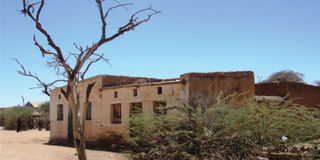Sheikh, a ‘city of the dead’

PHOTO | JOHN FOX
In soporific Odweine.
What you need to know:
- The Somaliland town offers a break from the heat of dry areas and dramatic views
“So we will be spending two days in Sheikh?” my colleague asked. “Isn’t that a rather dead place?”
At the time, neither of us had any idea how ironic that question was. It was only when we were there that we discovered that Sheikh is, indeed, the site of a necropolis — a “city of the dead” — that dates back to the 13th century.
Small town
But, first, let me make it clear where Sheikh is. It’s a small town in Somaliland on top of the escarpment that runs parallel to the Gulf of Aden, right the way from Djibouti to the west and beyond Bossaso to the east in Puntland. And the views from the escarpment up to Sheikh are even more dramatic than our own Italian road down to Mahiu.
Sheikh is at about the same altitude as Nairobi. After the rather enervating heat we had experienced in the port of Berbera on the plain that runs along the coast, we found nothing deadly about the weather in Sheikh. It was chilly by day, even when the sun was out – and at night it was certainly a two-blankets temperature.
When the British were in charge in Somaliland, Sheikh was their favourite place for a retreat from the heat of the arid lands. It was here that they established schools and, of course, a club. A veterinary college was built after independence, during the regime of Siad Barre. It still attracts students from all over the Horn of Africa.
Sheikh also seems to be a favourite place for the Prince of Kuwait. He has acquired a large estate just to the east of the town, well fenced and with watchtowers at all four corners. We were told that the Prince is a frequent visitor. Presumably, it is a good place to relax after the desert heat of Kuwait. Perhaps he brings his falcons, too.
Back at the Mansoor Hotel in Berbera we had seen three elegantly robed Arabs with their equally elegantly dressed falcons. Falconry is a much-favoured sport of the rich in Arabia.
We had only two days in Sheikh and we were very busy. But we found time to visit the necropolis.
Our guide was a young woman called Qadan. She led our vehicle on a brief but tortuous drive around homesteads and kiosks of the town. Then we came upon this open space, five or six times the size of a football pitch. But you couldn’t play football there because it was strewn with large and jagged stones. This was the ancient burial ground.
Qadan told us the story. Centuries back – eight centuries, if the Lonely Planet is to be believed (yes, the Lonely Planet Guide to Ethiopia has eight pages on Somaliland) — an old holy man entered the town.
They gave him a frosty welcome (the only chilly place where that would have been possible in Somaliland). In revenge he told them that they should not leave their houses in the morning — or else something terrible would happen to them. But a young woman (it had to be a woman) disobeyed and opened her door. So the whole town was wiped out — but we don’t know how.
The sequel was that people from the mountains came to bury the dead — and then they went away again.
Qadan was rather upset that the town is now encroaching on the burial ground. “People, especially the young,” she said, “are not respecting the dead or the place.”
After the two days, we drove on through Burao 100 kilometres further to the east, and then turning west along a sandy road for 50 kilometres to the small town of Odweine.
This last stretch was across a flat plateau, covered mostly with stunted clumps of grass. But it was an amazing drive. The occasional acacia trees stood out majestically on the plain; there were many tall anthills, some of them quite phallic in their rising to the sky.
There were many Thompson gazelles, a few dik diks, and a gerenuk stretching its long neck to find the sparse leaves on a thorn bush.
Unobtrusively hospitable
Odweine was not dead either, but it was certainly soporific in its heat. And it was unobtrusively hospitable. We bought a cold soda. The shopkeeper led us through the back and, we assumed, to a café area. It turned out to be her bedroom — where we finished our sodas and biscuits sitting on her big bed.
After Odweine, we were tempted to take a shortcut west to Hargeisa. But we were warned that the road was stony, not very obvious in places, and maybe not secure.
Since we had only the one vehicle, we decided to retrace our wheels and take the long way back through Burao, Sheikh and Berbera.
John Fox is Managing Director, iDC




